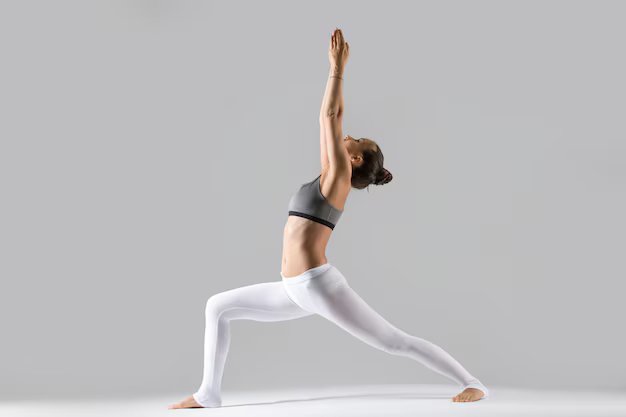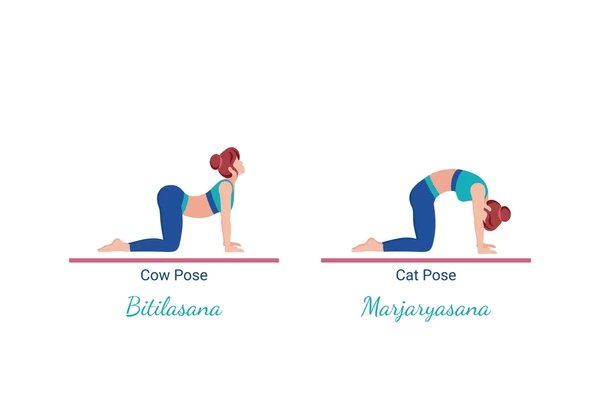Beginner's Guide For Yoga
Published On : 20th Nov 2024

Yoga is a fantastic activity that benefits both the body and mind by improving flexibility, strength, relaxation, and mindfulness. It is crucial for beginners to have patience and be open-minded when starting yoga, so they can gradually develop their practice.
Understand the Basics
Yoga is a combination of physical postures (asanas), breathing exercises (pranayama), and meditation techniques. It’s a holistic practice that connects the body, mind, and spirit.

- Asanas: Asanas are physical postures used in yoga for developing strength, flexibility, balance, and relaxation. The postures can vary from easy poses for beginners to difficult poses for advanced practitioners.
- Pranayama: Pranayama involves regulating the breath during yoga practice. Pranayama consists of different breathing methods that assist in controlling the prana (life force) flow within the body, fostering physical well-being, mental focus, and emotional stability. It is a key component of yoga that enhances the asanas (postures) and readies the mind for meditation.
- Meditation: Meditation is a practice that involves training the mind to focus and achieve a state of mental clarity, emotional calm, and heightened awareness. It has been practiced for thousands of years in various cultures and spiritual traditions and is now widely embraced for its mental health benefits and stress-relieving qualities. Meditation can help you cultivate mindfulness, increase your ability to concentrate, and develop a deeper sense of inner peace.



Essential Yoga Equipment
While yoga can be practiced with little to no equipment, having some basic gear can enhance your experience, improve comfort, and support your practice.

- Yoga Mat: A yoga mat provides a non-slip surface that cushions your body during poses and protects your joints from hard floors. It gives you a stable surface to practice on and prevents slipping during standing or balancing poses.
-
Comfortable Clothing: Wearing comfortable, breathable clothing is important for moving freely through yoga poses. Proper yoga attire allows you to stretch and move comfortably without distraction. Choose moisture-wicking materials to keep you cool and dry, especially during hot yoga.
-
Yoga Blocks: Yoga blocks, which are durable rectangular blocks, aid in adjusting poses, offering assistance, and improve alignment. Blocks are great for beginners to deepen stretches, enhance balance, and make challenging poses more accessible. Foam blocks are lightweight and soft, while cork and wooden blocks offer more stability and firmness.

-
Yoga Strap: A yoga strap is a long belt that helps you achieve a deeper stretch, especially if you’re not yet flexible enough to reach certain positions. It assists in stretching and helps with alignment, making it easier to maintain proper form in poses.

Learn Basic Poses
Starting with some simple, foundational poses will help you build confidence. Learning basic yoga poses is a great way to build a strong foundation for your practice. These poses help improve flexibility, strength, balance, and mindfulness.

-
Mountain Pose (Tadasana): A standing pose where you stand tall with feet together, arms by your sides, and chest lifted. It improves posture, strengthens legs, and promotes awareness of the body.
You can also refer to the help video link of this pose/asana, Here.
-
Downward-Facing Dog (Adho Mukha Svanasana): Start on your hands and knees, then lift your hips up and back to create an inverted V-shape. It strengthens the arms and legs, stretches the hamstrings and calves, and improves circulation.
You can also refer to the help video link of this pose/asana, Here.
-
Child’s Pose (Balasana): A resting pose that promotes relaxation and stretches the back. Kneel on the floor, sit back on your heels, and stretch your arms forward while lowering your forehead to the mat. It stretches the back, shoulders, and hips and also it promotes relaxation.
You can also refer to the help video link of this pose/asana, Here.
-
Virabhadrasana I: A powerful standing pose that strengthens the legs, opens the hips, and stretches the chest and arms. Stand in Mountain Pose and step your left foot back about 3-4 feet. Turn your left foot out about 45 degrees, and bend your right knee so it’s directly over your ankle. Keep your hips facing forward and raise your arms overhead, palms facing each other. Keep your back leg straight and grounded as you reach up and lengthen your spine. Hold for several breaths, then switch sides. It strengthens the legs, stretches the chest, shoulders, and groin, improves focus and stability.
You can also refer to the help video link of this pose/asana, Here.
-
Cat-Cow (Marjaryasana-Bitilasana): It is a gentle, flowing movement between two poses that warms up the spine, improves flexibility, and helps connect breath to movement. It’s an excellent pose for beginners and a staple in many yoga practices.
You can also refer to the help video link of this pose/asana, Here.
-
Tree Pose (Vrksasana): A balancing pose that strengthens the legs and core while improving focus and stability. Stand tall in Mountain Pose. Shift your weight onto your left foot, and place your right foot on the inside of your left thigh or calf (avoid placing it on the knee). Bring your hands together in front of your chest in a prayer position or extend them overhead. Focus on a point in front of you to help maintain your balance. Hold for several breaths, then switch sides. It strengthens legs and core, improves balance, and enhances concentration.
You can also refer to the help video link of this pose/asana, Here.
-
Corpse Pose (Savasana): Savasana, or Corpse Pose, is a restorative yoga posture often practiced at the end of a session. It encourages deep relaxation, helps integrate the benefits of your practice, and calms the mind. It’s deceptively simple yet profoundly effective. Lie flat on your back with your arms relaxed by your sides, palms facing up. Close your eyes and breathe naturally, allowing your body to relax completely.
You can also refer to the help video link of this pose/asana, Here.
Focus on Breathing
Breathing is a key element in yoga. Practicing mindful breathing helps you stay present and relaxed during your yoga session.

-
Equal Breathing (Sama Vritti): Inhale for a count of four, then exhale for a count of four, ensuring that your breath is smooth and even.
-
Tips for Success:
- Be Patient: It’s natural for your mind to wander. When it does, gently guide your focus back to your breath.
- Practice Regularly: Even 5 minutes a day can bring noticeable benefits over time.
- Create a Quiet Space: Choose a calm environment free from distractions.
- Use Props: Sit on a cushion or bolster for better comfort and posture.
- Incorporate Breathing into Daily Life: Practice mindful breathing during daily activities like walking, cooking, or commuting.
-
When to Focus on Breathing:
- During Yoga: Synchronize your breath with movements for better flow and alignment.
- Before Meditation: Use breathing techniques to settle your mind and body.
- Stressful Moments: Deep, intentional breaths can help calm nerves and reduce anxiety.
- Before Sleep: Relaxing breathing techniques can help prepare your body and mind for restful sleep.

Focusing on your breath is a simple yet powerful practice that can transform not just your yoga practice but also your daily life.
Start with Short Sessions
Begin with shorter yoga sessions (10-20 minutes), gradually increasing the time as you become more comfortable.
Starting with short yoga sessions is a great way to ease into your practice, build consistency, and avoid feeling overwhelmed. Even 10–15 minutes a day can bring significant benefits over time.

-
Why Start with Short Sessions?
-
Manageable Time Commitment: Short sessions are easier to fit into a busy schedule.
-
Develop a Habit: It’s easier to commit to a smaller goal and gradually expand.
-
Avoid Burnout: Short practices prevent tiredness and help you stay motivated.
-
Focus on Quality: Shorter sessions encourage mindful practice and proper technique.
-
Gradually Build Your Practice: Once you’re comfortable with short sessions, you can:
-
Increase Duration: Gradually extend your sessions by 5–10 minutes as your stamina grows.
-
Try Different Styles: Explore various types of yoga, such as Hatha for relaxation or Vinyasa for a more dynamic flow.
-
Set Goals: Focus on specific areas like flexibility, strength, or stress relief.
-
Benefits:
- Improves Energy: Even brief yoga sessions can boost your energy and mood.
- Reduces Stress: A few minutes of mindful movement and breathing can lower stress levels.
- Builds a Habit: Small, consistent practices lead to long-term progress.
Consistency is Key
Try to practice yoga regularly to see progress. Even practicing for just 10-15 minutes daily can make a significant difference. The more you practice, the more flexible and comfortable you’ll become with the poses.

Consistency is indeed the cornerstone of a successful yoga practice and achieving long-term benefits. Regular practice helps you build strength, flexibility, mindfulness, and discipline over time.
Explore Different Types of Yoga
There are many styles of yoga, each with a different focus. Here are a few you might want to explore as a beginner:

-
Hatha Yoga: A gentle, slower-paced practice focusing on basic poses and breathing.
You can also refer to the help video link of this yoga, Here.
-
Vinyasa Yoga: A more dynamic style that involves flowing from one pose to the next in coordination with the breath.
You can also refer to the help video link of this yoga, Here.
-
Yin Yoga: A slow-paced practice that involves holding poses for longer periods, focusing on deep stretching.
You can also refer to the help video link of this yoga, Here.
-
Restorative Yoga: A calming, relaxing practice designed to release tension and relax the body.
You can also refer to the help video link of this yoga, Here.
-
Power Yoga: A more intense, fitness-focused version of Vinyasa, for those seeking a more physically demanding practice.
You can also refer to the help video link of this yoga, Here.
Sample Beginner’s Routine
Here’s a simple routine you can try at home:

-
Mountain Pose (Tadasana)- 30 seconds
-
Downward-Facing Dog (Adho Mukha Svanasana)- 1 minute
-
Warrior I (Virabhadrasana I)- 30 seconds each side
-
Cat-Cow (Marjaryasana-Bitilasana)- 1 minute
-
Child’s Pose (Balasana) - 1 minute
-
Tree Pose (Vrksasana)- 30 seconds each side
-
Corpse Pose (Savasana)- 3-5 minutes of relaxation
This routine provides a gentle full-body stretch and builds a foundation for more advanced practices.

































